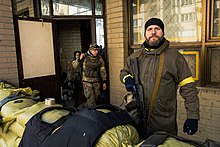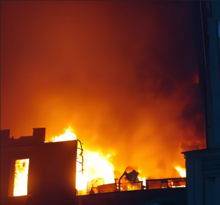Battle of Kyiv (2022)
Initially, Russian forces captured key areas to the north and west of Kyiv, leading to international prediction of the city's imminent fall.
Poor Russian logistics and tactical decisions helped the defenders to thwart efforts at encirclement, and, after a month of protracted fighting, Ukrainian forces began counterattacking.
A key supply point for Russian troops near Kyiv, the airport, located in Hostomel, a town northwest of the city, was captured the following day.
[34]On the morning of 25 February, three Russian saboteurs, dressed as Ukrainian soldiers, entered Obolon District, 10 kilometres (6 mi) north of the Verkhovna Rada building, the seat of the parliament of Ukraine.
[37][38] Several hours later, a Ukrainian Sukhoi Su-27 fighter aircraft piloted by Colonel Oleksandr Oksanchenko was shot down over the city and crashed into an apartment building.
[43] According to President of Ukraine, Volodymyr Zelenskyy, Ukrainian forces managed to repel a Russian offensive and continued to hold Kyiv and its surrounding areas.
[51] During the night, a Russian convoy attempted to set up a temporary base at Syrets Metro, which was met with a deadly confrontation with Ukrainian troops.
[42] 18,000 guns were distributed amongst citizens during the first day of the battle, while the Ukrainian Territorial Defense Forces, normally kept in reserve, were activated upon the start of the attack.
[25] On 26 February, Ukrainian interior minister Denys Monastyrsky announced that civilian volunteers in Kyiv had been given more than 25,000 assault rifles, and approximately 10 million bullets, as well as rocket-propelled grenades and rocket launchers.
On 28 February, a fresh wave of Russian troops advanced towards Kyiv, but little direct combat occurred, with only three missiles being fired at the city that day.
[62][63]On the morning of 1 March, the Russian Ministry of Defense issued an evacuation notice to local civilians stating that they intended to target Ukrainian transmission facilities around Kyiv and that all nearby residents should leave the area.
[71][72] Further Russian shelling struck the neighborhoods of Rusanivka and Kurenivka and the suburbs of Boyarka and Vyshneve, as well as the area around Kyiv International Airport.
[note 1][73][74] That day, Klitschko banned the sales of alcohol in Kyiv while appealing to shop owners and pharmacy chains not to “take advantage” of the situation by raising the prices of "food, essential goods and medicines".
[78] Estonian Defence Forces intelligence chief Margo Grosberg estimated that the advancing Russian convoy would arrive to Kyiv's outer suburbs in at least two days, after which they would try to lay siege to the city.
[89] On 8 March, CIA director William J. Burns stated, "Instead of seizing Kyiv within the first two days of the campaign, which is what [Putin's] plan was premised upon, after nearly two full weeks they still have not been able to fully encircle the city.
"[90] Ukrainian-born U.S. military analyst Michael Kofman commented, "At the outset [the Russian Armed Forces] thought they could introduce units very quickly into the capital Kyiv (...).
Later that day, Russian and Ukrainian authorities agreed to make a temporary humanitarian corridor around Kyiv, resulting in the mass evacuation of civilians from the suburbs.
[33] On 12 March, a Russian loitering munition, identified as a ZALA Kub-BLA, was shot down over the Podil neighborhood, causing a fire in the State Savings Bank of Ukraine building.
Later in the morning, Russian forces shelled residential areas, including the Sviatoshynski, Podilskyi and Osokorky districts, setting multiple buildings ablaze.
[116] Shelling hit a parking lot in the northern area of the city,[117] killing Russian journalist Oksana Baulina and wounding two people.
[119] A British intelligence report on 25 March said that Ukraine had retaken towns as far as 35 kilometres (22 mi) from the city as Russian forces began to run out of supplies.
[130] The discovery of Russian war crimes committed during the offensive, particularly in Bucha, led to additional rounds of sanctions against Russia and pledges of further military aid to Ukraine.
[131] On 30 March, following the withdrawal, a Pentagon spokesperson stated that the U.S. Department of Defense believed that taking Kyiv "was a key objective" if one "[looks] at what they were doing in those early days.






